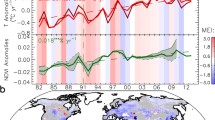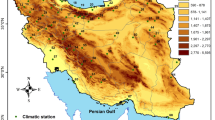Abstract
In many regions of the world, increasing temperatures in recent decades are paradoxically associated with declining pan evaporation, but evidence is sparse for this trend from the southern hemisphere in general and sub-Saharan Africa in particular. In this study, we examined changes in pan evaporation and four other meteorological variables (rainfall, wind run, temperature and vapour pressure deficit) at 20 climate stations in the predominantly winter-rainfall Cape Floristic Region (CFR) of South Africa over the period 1974–2005. Our results show that pan evaporation has declined significantly at 16 climate stations at an average rate of 9.1 mm a − 2 while wind run has declined significantly at all climate stations by more than 25% over the study period. Annual rainfall has not changed significantly at any of the climate stations while maximum temperature has increased significantly at all but one climate station at an average rate of 0.03°C a. − 1 over the study period. The trends in vapour pressure deficit are mixed and no clear regional pattern is evident. Our results raise important questions about the predicted catastrophic impact that the projected changes in twenty-first century climates will have on the rich flora of the region. If evaporative demand has declined over the last 30 years in the Cape Floristic Region then it is possible that more water has become available for plant growth, infiltration and runoff despite the widespread increase in temperature. However, decreased pan evaporation and wind run combined with increased temperatures could potentially reduce transpiration and exacerbate heat stress of plants on increasingly frequent hot and windless days during the summer drought. Contrary to other predictions for the area, it is also likely that the changing conditions will decrease the frequency and/or intensity of fires which are an important component of the ecology of the fire-adapted CFR. Consideration of other factors besides changes in temperature and rainfall are essential in debates on the impact of climate change on the vegetation of this region.
Similar content being viewed by others
References
Bomhard B, Richardson DM, Donaldson JS, Hughes GO, Midgley GF, Raimondo DC, Rebelo AG, Rouget M, Thuiller W (2005) Potential impacts of future land use and climate change on the Red List status of the Proteaceae in the Cape Floristic Region, South Africa. Glob Chang Biol 11:1452–1468
Brutsaert W (2006) Indications of increasing land surface evaporation during the second half of the 20th century. Geophys Res Lett 33(20):1410–1411. doi:10.1029/2006GL027532
Burn DH, Hesch NM (2007) Trends in evaporation for the Canadian prairies. J Hydrol 336:61–73
Cong ZT, Yang DW, aNi GH (2009) Does evaporation paradox exist in China? Hydrol Earth Sys Sci 13:357–366
Coudun C, Gégout J-C, Piedallu C, Rameau J-C (2006) Soil nutritional factors improve models of plant species distribution: an illustration with Acer campestre (L.) in France. J Biogeogr 33:1750–1763
Cowling RM, Pressey RL, Rouget M, Lombard ET (2003) A conservation plan for a global biodiversity hotspot—the Cape Floristic Region, South Africa. Biol Conserv 112:191–216
Cramer MD, Verboom GA, Hawkins HJ (2009) The importance of nutritional regulation of plant water flux. Oecologia 161:15–24
Eamus D, Palmer AR (2007) Is climate change a possible explanation for woody thickening in arid and semi-arid regions? Res Lett Ecol 37364:5. doi:10.1155/2007/37364
El Nasr MN, Alazba AA (2010) Simple statistical equivalents of Penman-Monteith formula’s parameters in the absence of non-basic climatic factors. Arab J Geosci. doi:10.1007/s12517-010-0231-1
Elith J, Leathwick J (2009) Species distribution models: Ecological explanation and prediction across space and time. Ann Rev Ecolog Evol Syst 40:677–697
Fu G, Charles SP, Yu J (2009) A critical overview of Epan trends over the last 50 years. Clim Change 97:193–214
Heikkinen RK, Luoto M, Araujo MB, Virkkala R, Thuiller WS, Martin T (2006) Methods and uncertainties in bioclimatic envelope modelling under climate change. Prog Phys Geogr 30:751–777
Hobbins MT, Ramirez JA, Brown TC (2004) Trends in Epan and actual evapotranspiration across the conterminous US: Paradoxical or complementary? Geophys Res Lett 31(13):L13503
Hoffman MT, Rohde RF (2007) From pastoralism to tourism: The historical impact of changing land use practices in Namaqualand. J Arid Environ 70:641–658
IPCCRao GSP, De US (2007) Climate Change 2007: synthesis report. In: Parry ML, Canziani OF, Palutikof JP, van der Linden PJ, Hanson CE (eds) Intergovernmental panel on climate change. Cambridge University Press, Cambridge, pp 24–73
Jaswal AK, Rao GSP, De US (2008) Spatial and temporal characteristics of evaporation trends over India during 1971–2000. Mausam 59:149–158
Jovanovic B, Jones DA, Collins D (2008) A high-quality monthly Epan dataset for Australia. Clim Change 87:517–535
Li CQ, Li BG, Hong KQ (2008) Climate change and its effect on reference evapotranspiration and crop water requirement in Hebei Province, China during 1965–1999. J Agrometeorol 10:261–265
Liu B, Xu M, Henderson M, Gong W (2004) A spatial analysis of Epan trends in China, 1955–2000. J Geophys Res Atmos 109:L01812. doi:10.1029/2004JD004511
Liu B, Ma ZG, Xu JJ, Xiao ZN (2009) Comparison of Epan and actual evaporation estimated by land surface model in Xinjiang from 1960 to 2005. J Geogr Sci 19:502–512
Mackellar NC, Hewitson BC, Tadross MA (2007) Namaqualand’s climate: recent historical changes and future scenarios. J Arid Environ 70:604–614
McVicar TR, Van Niel TG, Li LT, Roderick ML, Rayner DP, Ricciardulli L, Donohue RJ (2008) Wind speed climatology and trends for Australia, 1975–2006: Capturing the stilling phenomenon and comparison with near-surface reanalysis output. Geophys Res Lett 35:L20403
Midgley GF, Thuiller W (2007) Potential vulnerability of Namaqualand plant diversity to anthropogenic climate change. J Arid Environ 70:615–628
Midgley GF, Hannah L, Millar D, Thuiller W, Booth A (2003) Developing regional and species-level assessments of climate change impacts on biodiversity: a preliminary study in the Cape Floristic Region. Biol Conserv 112:87–97
Midgley GF, Chapman RA, Hewitson B, Johnston P, DeWit M, Ziervogel G, Mukheibir P, Van Niekerk L, Tadross M, VanWilgen BW, Kgope B, Morant PD, Theron A, Scholes RJ, Forsyth GG (2005) A status quo, vulnerability and adaptation assessment of the physical and socio-economic effects of climate change in the Western Cape. ENV-S-C 2005-073, p 170. CSIR Environmentek, Stellenbosch
Myers N, Mittermeier RA, Mittermeier CG, da Fonseca GAB, Kents J (2000) Biodiversity hotspots for conservation priorities. Nature 403:853–858
Nobel PS (2005) Physiochemical and environmental plant physiology. Academic Press, San Diego, California
Noble IR, Gill AM, Bary GAV (1980) McArthur’s fire danger meters expressed as equations. Austral Ecol 5:201–203
Olson DM, Dinerstein E (2002) The Global 200: priority ecoregions for global conservation action. Ann Miss Bot Gard 89:199–224
Pearce JL, Boyce MS (2006) Modelling distribution and abundance with presence-only data. J Appl Ecol 43:405–412
Pearson RG, Dawson TP (2003) Predicting the impacts of climate change on the distribution of species: are bioclimate envelope models useful? Glob Ecol Biogeogr 12:361–371
Rayner DP (2007) Wind run changes: the dominant factor affecting Epan trends in Australia. J Clim 20:3370–3394
Roderick ML, Farquhar GD (2002) The cause of decreased Epan over the past 50 years. Science 298:1410–1411
Roderick ML, Farquhar G (2004) Changes in Australian Epan from 1970 to 2002. Int J Climatol 24:1077–1090
Roderick ML, Rotstayn LD, Farquhar GD, Hobbins MT (2007) On the attribution of changing pan evaporation. Geophys Res Lett 34:L17403. doi:10.1029/2007GL031166
Roderick ML, Hobbins MT, Farquhar GD (2009a) Pan evaporation trends and the terrestrial water balance. I. Principles and Observations. Geogr Compass 3:746–760
Roderick ML, Hobbins MT, Farquhar GD (2009b) Pan evaporation trends and the terrestrial water balance. II. Energy Balance and Interpretation. Geogr Compass 3:761–780
Roth-Nebelsick A (2001) Computer based analysis of steady state and transient heat transfer of small-sized leaves by free and mixed convection. Plant Cell Environ 24:631–640
Stanhill G, Moller M (2008) Evaporative climate change in the British Isles. Int J Climatol 28:1127–1137
Thuiller W, Lavorel S, Midgley G, Lavergne S, Rebelo T (2004) Relating plant traits and species distributions along bioclimatic gradients for 88 Leucadendron taxa. Ecol 85:1688–1699
Valiantzas J (2006) Simplified versions for the Penman evaporation equation using routine weather data. J Hydrol 331:690–702
van Wilgen BW (2009) The evolution of fire and invasive alien plant management practices in fynbos. S Afr J Sci 105:335–342
van Wilgen BW, Forsyth GG, de Klerk H, Das S (2010) Fire management in Mediterranean-climate shrublands: a case study from the Cape fynbos, South Africa. J Appl Ecol 47:631–638
Wand SJE, Steyn WJ, Theron KI (2008) Vulnerability and impact of climate change on pear production in South Africa. Acta Hort 800:263–272
Wang Y, Jiang T, Bothe O, Fraedrich K (2007) Changes of Epan and reference evapotranspiration in the Yangtze River basin. Theor Appl Climatol 90:13–23
Warburton M, Schulze RE, Maharaj M (2005a) Is South Africa’s temperature changing? An analysis of trends from daily records, 1950–2000. In: Schulze RE (ed) Climate change and water resources in southern Africa: studies on scenarios, impacts, vulnerabilities and adaptation, pp 275–296. WRC Project K5/1430. ISBN No: 1-77005-365-4
Warburton M, Schulze RE (2005b) Historical precipitation trends over southern Africa: a hydrology perspective. In: Schulze RE (ed) Climate change and water resources in southern Africa: studies on scenarios, impacts, vulnerabilities and adaptation, pp 325–338. WRC Project K5/1430. ISBN No: 1-77005-365-4
Withers CS, Nadarajah S (2006) Evidence of trend in return levels for daily windrun in New Zealand. J Meteorol Soc Jpn 84:805–819
Yates MJ, Verboom GA, Rebelo AG, Cramer MD (2009) Ecophysiological significance of leaf size variation in Proteaceae from the Cape Floristic Region. Funct Ecol 24:485–492
Zar JH (1984) Biostatistical analysis. Prentice-Hall, Edgewood Cliffs
Zhang YQ, Liu CM, Tang YH, Yang YH (2007) Trends in Epan and reference and actual evapotranspiration across the Tibetan Plateau. J Geophys Res Atmos 112(D12):D12110
Zheng H, Liu X, Liu C, Dai X, Zhu R (2009) Assessing contributions to pan evaporation trends in Haihe River Basin, China. J Geophys Res Atmos 114:D24105. doi:10.1029/2009JD012203
Author information
Authors and Affiliations
Corresponding author
Additional information
An erratum to this article can be found at http://dx.doi.org/10.1007/s10584-011-0113-x
Rights and permissions
About this article
Cite this article
Hoffman, M.T., Cramer, M.D., Gillson, L. et al. Pan evaporation and wind run decline in the Cape Floristic Region of South Africa (1974–2005): implications for vegetation responses to climate change. Climatic Change 109, 437–452 (2011). https://doi.org/10.1007/s10584-011-0030-z
Received:
Accepted:
Published:
Issue Date:
DOI: https://doi.org/10.1007/s10584-011-0030-z




